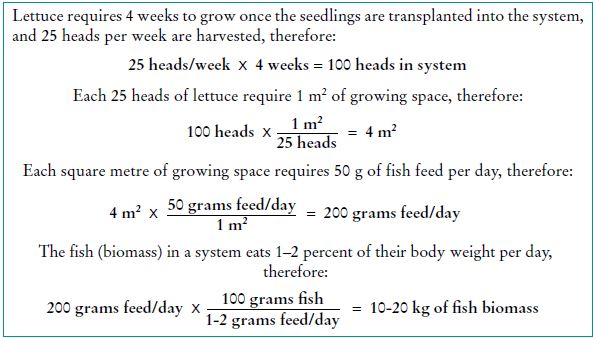BALANCING THE FISH AND PLANTS: COMPONENT CALCULATIONS
Aquaponic systems need to be balanced. The fish (and thus, fish feed) need to supply
adequate nutrients to the plants; the number of plants should be adequate to use all the
nutrients released, but not in excess to prevent any risk of deficiencies. The biofilter
needs to be large enough to process all of the fish wastes, and enough water volume
is needed to circulate this system. This balance can be tricky to achieve in a new
system, but this section provides helpful calculations to estimate the sizes of each of
the components.
The most successful way to balance an aquaponic system is to use the feed rate
ratio described in Section 2.1.4 of this publication. This ratio is the most important
calculation for aquaponics so that the fish and plants can thrive symbiotically within
the aquaponic ecosystem.
The ratio estimates how much fish feed should be added each day to the system, and it
is calculated based on the area available for plant growth. This ratio depends on the type
of plant being grown; fruiting vegetables require about one-third more nutrients than
leafy greens to support flowers and fruit development. The type of feed also influences
the feed rate ratio, and all calculations provided here assume an industry standard fish
feed with 32percent protein. Lower-protein feeds can be fed at higher rates.
Leafy green plants Fruiting vegetables
40–50g of fish feed per square metre 50–80g of fish feed per square metre
The recommended first step in the calculation is to determine how many plants
are needed. Plants are most likely the most profitable part in small-scale aquaponics
because of the high turnover rate. On average, plants can be grown at the following
planting density. These figures are only averages, and many variables exist depending
on plant type and harvest size, and therefore should only be used as guidelines.
Leafy green plants Fruiting vegetables
20–25 plants per square metre 4 plants per square metre
Choose the amount of growing area needed using the above metric (leafy vs.
fruiting). The surface area needs to be chosen by the farmer to meet market or food
production targets. This also depends on the crop, because some plants require more
space and grow more slowly than others. Once the desired number of plants has
been chosen, it is then possible to determine the amount of growing area needed and,
consequently, the amount of fish feed that should be added to the system every day.
Once the amount of fish feed has been calculated, it is possible to determine the
biomass of the fish needed to eat this fish feed. Different-sized fish have different
feed requirements and regimes, this means that many small fish eat as much as a few
large fish. In terms of balancing an aquaponic unit, the actual number of fish is not as
important as the total biomass of fish in the tank. On average, the fish will consume
1–2percent of their body weight per day during the grow-out stage, which correspond
to a body mass above 50g. On the contrary small/young fish eat more than large ones,
as a percentage of body weight.
Fish feeding rate
1–2 % of total body weight per day
The following example demonstrates how to conduct this set of calculations: In
order to produce 25 heads of lettuce per week, an aquaponic system should have
10–20kg of fish, fed 200grams of feed per day, and have a growing area of 4m2. The
calculations are as follows:

Although extremely helpful, this feed ratio is really only a guide, particularly for
small-scale units. There are many variables involved with this ratio, including the size
and type of fish, water temperature, protein content of the feed, and nutrient demands
of the plants, which may change significantly over a growing season. These changes
may require the farmer to adjust the feeding rate. Testing the water for nitrogen helps
to determine if the system remains in balance. If nitrate levels are too low (less than
5 mg/litre), then slowly increase the feed rate per day without overfeeding the fish.
If the nitrate levels are stable, then there may be deficiencies in other nutrients and
supplementation may be required especially for calcium, potassium and iron. If nitrate
levels are increasing then occasional water exchanges will be necessary as nitrate rises
above 150 mg/litre. Increasing nitrate levels suggest that the concentration of other
essential nutrients is adequate.
Practical system design guide for small-scale aquaponic units

Notes:
1. The recommended fish density is based on a maximum stocking density of 20kg/1000litres. Higher densities are
possible with further aeration and mechanical filtration, but this is not recommended for beginners.
2. The recommended feeding rate is 1percent of body weight per day for fish of more than 100g of body mass. The
feeding rate ratio is: 40–50g/m2 for leafy greens; and 50–80g/m2 for fruiting vegetables.
3. The volumes for mechanical separator and biofilter should be 10–30percent of total fish tank volume. In reality,
the choice of containers depends on their size, cost and availability. Biofilters are only needed for NFT and DWC
units; mechanical separators are applicable for NFT, DWC units and media bed units with a fish density of more
than 20kg/1000litres.
4. These figures assume the bacteria are in optimal conditions all the time. If not, for a certain period (winter), extra
filtration media may need to be added as a buffer. Different values are provided for the two most common biofilter
media based on their respective specific surface area.
5. Figures for plant growing space include only leafy greens. Fruiting vegetables would have a slightly lower area.